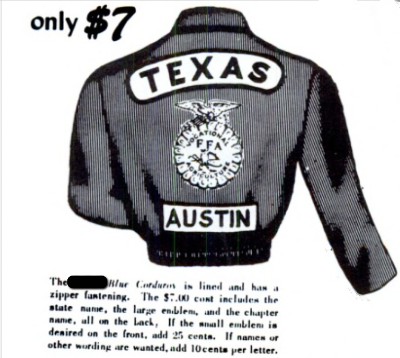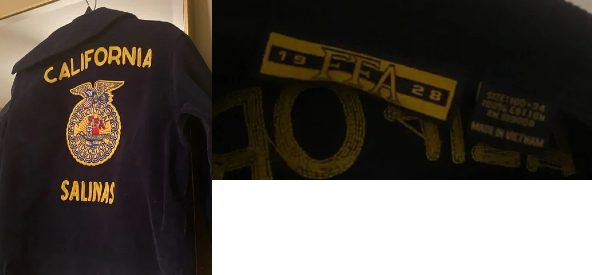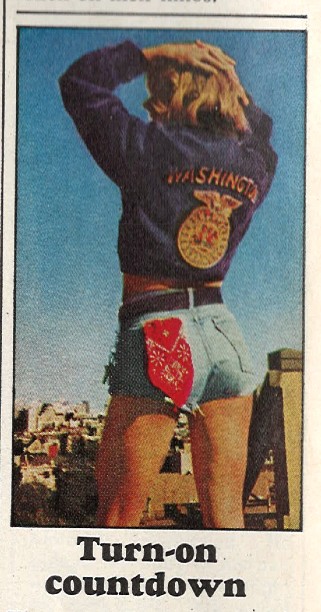During the past month the Friday Footnotes have focused on the FFA jacket. We will wrap up that series of Footnotes with a quiz about the FFA jacket. Half of the questions (the odd numbered questions) are based upon what has been written in the Footnotes over the previous month. How closely did you read the Footnotes?
The rest of the questions (the even numbered items) are true trivia questions comprised of little known facts uncovered while writing the Friday Footnotes. Let the game begin!!
The answer key is at the very end of this Footnote.
- The person regarded as the Father of the FFA Jacket is:
A. E. M. Tiffany
B. J. H. “Gus: Lintner
C. Henry Groseclose
D. Larry Case
- The jacket that served as the model for the FFA jacket had a ________ embroidered on the back of it.
A. Horse
B. Native American
C. Motorcycle
D. Bulldog
- The company that produced the first FFA jacket and is currently a supplier of FFA jackets is:
A. Universal
B. Fab Knit
C. Ringer St. Croix Garment Company
D. DVB Enterprises
- In 1935 the FFA Board of Trustees approved a policy that national FFA officers wear the official jacket at the national FFA convention. The motion further stipulated that the national officers:
A. Wear the matching corduroy pants
B. Pay half the cost of the jacket
C. Wear bow ties with the jacket
D. All of the above
- The early FFA jackets were fastened using
A. Buttons
B. Zippers
C. Snaps
D. Draw Strings
- In April of 1937 the company that made FFA jackets was advised by the FFA Board of Trustees to stop
A. Using green thread on the FFA emblem
B. Using purplish tinted corduroy
C. Sending out jackets with the pockets sewed shut
D. Using script writing for the names on the jackets
- The location of the first factory producing FFA jackets was:
A. St. Croix, Minnesota
B. Waco, Texas
C. Danville, Illinois
D. Van Wert, Ohio
- During World War II (October, 1943) the FFA Official Merchandise Committee recommended the:
A. Cessation of producing FFA jackets because of the wartime shortage of cotton
B. Use of denim be allowed in the production of FFA jackets
C. Corduroy now being used for FFA pants be used for jackets instead
D. Awarding of FFA jackets to FFA members who sold $500 worth of war bonds
- A distinct feature of 1940 era FFA jackets was:
A. Gold darts (arrows) sewed around the pocket
B. The FFA emblem imprinted on the sleeve buttons
C. A small pocket inside the jacket for pocket watches
D. All of the above were found in 1940 era jackets
- In May of 1951 The Future Farmer magazine published by the Texas FFA carried the ad below advertising FFA jackets from the Chapter Supply Company of Danville, Illinois. The Texas FFA received 10% of all Chapter Supply Jacket sales in Texas. In describing the color of the jacket, what word has been blacked out immediately preceding “? blue corduroy”?
A. National
B. Navy
C. Royal
D. Bluebonnet

Figure 1. Advertisement from the May 1951 Texas Future Farmer Magazine.
- In the early 1950s the dying process used on the corduroy for jackets was changed from a sulfa dye process to a vat dye process. This was because:
A. It was cheaper
B. The vat dye did not fade and wear off on white shirts
C. The vat dye process was better for the environment
D. All of the above were reasons for the change
- In January of 1955 the New Jersey FFA Association requested the National FFA establish a policy that FFA members:
A. Serve a probationary period before being allowed to wear the official jacket
B. Earn the Greenhand degree before being allowed to wear the official jacket
C. Pass a test on the proper use of the FFA jacket before being allowed to wear the official jacket
D. Both B and C are correct
- The first FFA jackets specifically designed for female FFA members appeared in
A. 1965
B. 1969
C. 1970
D. 1971
- In July of 1956 Lenny Gamage asked the FFA Board to consider furnishing ___ official FFA jackets to each national officer because of their frequent use.
A. Two
B. Three
C. Four
D. Five
- In 2004 the National FFA worked with the FFA jacket corduroy supplier to correct a “problem” with the corduroy. The problem was:
A. The color of the material was a dark navy color, sometimes nearly purple
B. The corduroy material used to make jackets varied in thickness
C. The colors tended to fade when exposed to the sun for any length of time
D. The cotton used to make the corduroy had pesticide residues
- In 1963 the FFA Board passed a motion recommending that FFA members refrain from _______ while wearing the official FFA jacket.
A. Drinking beer
B. Gambling
C. Seeing “adult” movies
D. Smoking
- In the early 2000s the issue of “offshore sourcing” of a limited number of FFA jackets was raised. At the 2002 FFA convention the delegates:
A. Voted against offshore sourcing of the jackets
B. Approved the idea that FFA jackets should be manufactured in whatever location would ensure the lowest price while maintaining high quality.
C. Agreed that jackets could be manufactured in any country as long as the government of the country was not communistic.
D. Voted that the jackets had to be made in North America (Canada, USA, Mexico)
- At the 1993 FFA Convention the Communications and Public Relations Committee recommended that a pocket card with the __________ be placed in the pocket of every FFA jacket sent out.
A. FFA Creed
B. Proper use of the Jacket Guidelines
C. FFA Code of Ethics
D. Abbreviated History of the FFA
- In 2004 the FFA asked which university for help in re-inventing the FFA jacket?
A. Rutgers
B. Cornell
C. Purdue
D. Clemson
- This jacket was listed on the Poshmark website for sale for $90 and was identified as a “Vintage 1928 FFA Corduroy Jacket.” What is wrong with this claim? Circle all the answers that are correct!
A. FFA jackets back then were made from wool
B. FFA jackets were not manufactured in 1928
C. The wording on the emblem changed from “Vocational Agriculture” to “Agricultural Education” after 1988 thus it could not be a 1928 jacket
D. The tag indicates the jacket was made in Vietnam, this did not happen until about 20 years ago

Figure 2. The Poshmark “Vintage 1928 FFA Corduroy Jacket.”
Bonus Question 1. The image below (along with an accompanying article) was published in a nationally distributed magazine in September of 1975. The FFA considered bringing a lawsuit against the magazine. The name of the magazine?
A. Playboy
B. OUI
D. Penthouse
D. Esquire
Bonus Question 2: These two jackets were made in the 1960s. One was from the FFA Supply Service and one was from Holt’s Sporting Goods in Waco, Texas. Which is which?
Matching:
Left Jacket ______ A. FFA Supply Service
Right Jacket _____ B. Holt’s Sporting Goods

Concluding Remarks
Some things come and go but the FFA jacket has endured. The jacket is merely a piece of clothing but the values and history it represents is really what endures. Those of us who wore the blue and gold jackets can be proud of our heritage. And it is our mission to share this heritage with the next generation of agriculturalist.
A good teaching activity might be to have your students learn about the FFA jacket by studying the FFA Manual, the FFA Student Handbook, YouTube videos about the FFA jacket, Google searches, and this series of Friday Footnotes. It might be interesting to see what type of quiz on the FFA jacket they could produce.
The Answer Key
- B
- D
- A
- B
- C
- A
- D
- C. Matching corduroy pants were available at one time for FFA members.
- A
- C When the FFA was established there was no “official” blue color known as “National Blue”. The first jackets were Navy Blue. In January of 1954 the FFA Board decided that “Royal Blue” by JuIlliard be the blue used for jackets. Later, colors from the original jackets were used to create what is now National Blue (PMS 287). In the 1950s this advertisement was part of a lawsuit involving the National FFA and Chapter Supply Company. In the 1960s Texas FFA was using Fab Knit (also known as Holts Sporting Goods) to produce FFA jackets.
- B
- A
- D
- A In July of 1959 this number was increased to three jackets.
- A
- D Some FFA members from tobacco producing states disagreed with this suggestion and wrote letters to the FFA Magazine. During the 1960s there was an “adult” movie theater a couple of blocks from the convention center in Kansas City. The theater sold discounted tickets to FFA members. So members bought the tickets and when inside removed their jackets and sat on them. In the early 1960s there were numerous presentations and displays at the convention and in the FFA magazine about proper use of the jacket.
- B
- C
- D
- B. C. & D.
Bonus Question 1: B (OUI)
Bonus Question 2: Left jacket is from the FFA Supply Service. Right Jacket is from Holt’s Sporting Goods
